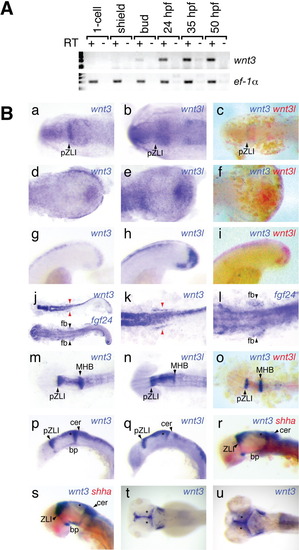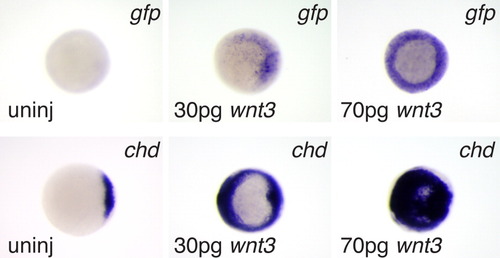- Title
-
Zebrafish wnt3 is expressed in developing neural tissue
- Authors
- Clements, W.K., Ong, K.G., and Traver, D.
- Source
- Full text @ Dev. Dyn.
|
Temporal and spatial expression of wnt3 during zebrafish embryonic development. A: RT-PCR analysis of wnt3 (top row) in total cDNA from whole embryos at the indicated stages of development. ef-1α was used as a positive control. B: WISH analysis of wnt3 expression. Embryos at various ages processed for expression of the mRNAs are shown. In all cases, anterior is to the left. a-c: Flat-mounted head views at 3-s show that wnt3 displays stronger expression in the presumptive ZLI (black arrows, pZLI), whereas wnt3l displays stronger expression in the prospective midbrain just posterior. d-f:Flat-mounted tailbud views at 3-s. Note wnt3 shows stronger expression in the lateral and posterior border of the tailbud. g-i: Lateral views of the tailbud at 18-s. wnt3l shows stronger and deeper expression in the tailbud. Comparative flatmount views of wnt3 and fgf24 at 22-s (j) and magnified images at the level of the finbud progenitors (k, l). wnt3 is expressed bilaterally (red arrowheads) in tissue just medial to the finbud progenitor fields marked by fgf24 (black arrowheads, fb). m-o: Dorsal flatmount views at 18-s. Both wnt3 and wnt3l are expressed in the developing diencephalon and mesencephalon, but wnt3 is expressed farther posterior into the presumptive cerebellum. p,q: Lateral views of the brainstem with eyes removed at 18-s confirm wnt3 expression in the presumptive cerebellum and demonstrate that wnt3 extends much farther ventrally at both the presumptive ZLI and the midbrain hindbrain boundary, reaching into the presumptive basal plate. r,s: At 24 and 30 hpf (lateral brain stem views, eyes removed), this trend continues. Double WISH with shha confirms the basal plate expression. At 4 dpf (t) and 6 dpf (u), wnt3 continues to be expressed in the optic tectum, and is visible in the otic vesicles (dorsal head views). bp, basal plate; cer, cerebellum; fb, finbud progenitors; MHB, midbrain-hindbrain boundary; pZLI, presumptive zona limitans intrathalamica; ZLI, zona limitans intrathalamica; *, optic tectum. |
|
Zebrafish Wnt3 can activate the canonical Wnt pathway. Zebrafish heterozygous for a gfp transgene under the control of a Wnt/β-catenin-dependent promoter (Tg(TOP:GFP)w25/+) were outcrossed, and the resulting embryos were allowed to develop uninjected (left column), or injected with either 30 pg (middle column) or 70 pg (right column) of wnt3 mRNA. At shield stage, embryos were fixed and processed by WISH for expression of either gfp (top row) or chd (bottom row) as indicated. Injected embryos showed a dose-dependent increase in canonical Wnt signaling-driven transcript abundance. One hundred percent of embryos displayed the phenotypes depicted for each condition. Non-transgenic siblings provided an internal control for gfp in situs (not pictured). EXPRESSION / LABELING:
|


